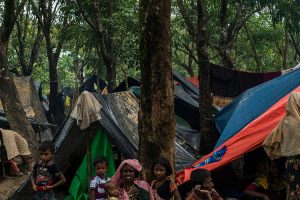Updated May 17
Information about the Ebola epidemic in the northern Bas-Uele province of the Democratic Republic of the Congo is confused, and conflicting statements have been issued. This post has been repeatedly updated since May 12.
What we know
- 21 suspected cases of Ebola infection
- 3 people have died
- Only 2 cases confirmed by lab testing
In a May 17 update, the World Health Organization said that, as of May 16, two new suspected Ebola cases were reported in Azande and Nambwa, bringing the total number of suspected infections to 21.
Three of the 21 people have died. To date, only two Ebola infections have been confirmed by the national laboratory.
The reported cases are from four areas: Nambwa – 13 cases and 2 deaths; Mouma – 3 cases and 1 death; and Ngayi – 4 cases and no deaths; and Azande – one case and no deaths. Two cases that were previously reported in Ngayi are now reported in Nambwa in addition to the new case there, and the case in Azande is new. WHO has not explained the reasons for these changes.
Approximately 400 close contacts of the people suspected to have Ebola infection have been registered and are being monitored. This is a dramatic rise on the 125 close contacts that WHO said were being monitored in its May 16 update.
The first case was first described by WHO on May 13. On April 22, a 39-year-old man presented symptoms and was taken on a motorbike to a health facility. He died on arrival. Another man who took care of him developed similar symptoms. The driver of the bike died on April 26.
A team of officials and scientists from the government and NGOs are visiting the area on May 17 and 18. WHO first response teams were scheduled to reach the affected area on May 12 or 13, Dr Yokouidé Allarangar, WHO representative in the DRC, said.
Unexplained rise in number of suspected infections
WHO said on May 12 that since April 22, nine cases with patients presenting haemorrhagic symptoms suspected to be caused by the Ebola virus have been reported. It said three people had died and six were hospitalized.
The organization has not explained the increase in the number of identified cases from nine to 19, nor the subsequent rise to 21.
Nine suspected #ebola cases in #DRC now reported, including 3 deaths. @WHO confirming only 2 cases, so far.
— Steve Herman (@W7VOA) May 14, 2017
Confusion over laboratory confirmation of infections
On May 17, WHO said two of five blood samples collected from the initial cases tested positive for the Zaire subtype of the Ebola virus. This may be attempting to clarify earlier confusion.
The May 16 WHO update said that laboratory testing has confirmed Ebola in two cases, and that this was communicated to WHO by the DRC Ministry of Health on May 11.
This conflicts with earlier WHO statements and with documentation the agency provided.
In a May 12 statement, WHO said the DRC Ministry of Health notified it on May 9 of a cluster of undiagnosed illnesses and deaths. WHO provided a letter from the health ministry dated May 11 which states that one of five samples had tested positive for the Zaire subtype of the Ebola virus, and that laboratory testing was ongoing.
The earliest report that states lab tests have confirmed a second Ebola case is a May 14 Reuters story citing WHO spokesperson Eugene Kabambi.
Kabambi told Reuters two days earlier that a person confirmed to be infected with Ebola had died, but this was not subsequently confirmed by any of the public WHO statements.
Ebola in DRC
This confirmed Ebola epidemic is the eighth in the DRC since 1976.
During the last outbreak which began on August 24, 2014, a total of 66 cases (38 confirmed and 28 probable) of the disease were reported. Forty-nine people died, including eight health workers, a fatality rate of 74.2 percent.
The last confirmed case was on October 4, 2014, and government declared the end of the epidemic on November 15 of that year.
Ebola virus disease
Ebola virus disease (EVD), formerly known as Ebola haemorrhagic fever, is a severe, often fatal illness in humans.
The virus is transmitted to people from wild animals and spreads through human-to-human transmission, via both direct contact with the bodily fluids of infected people, and with surfaces or materials like bedding, clothing contaminated with these fluids.
Health-care workers have frequently been infected while treating patients with suspected or confirmed EVD, and burial ceremonies in which mourners touch the body of the deceased person can also play a role in transmission.
People remain infectious as long as their blood contains the virus.
The incubation period ranges between 2 to 21 days, and people are not infectious until they develop symptoms. First symptoms are fever fatigue, muscle pain, headache and sore throat. This is followed by vomiting, diarrhoea, rash, and in some cases, both internal and external bleeding.
The average fatality rate is around 50%, but can range from 25% to as high as 90%.
The first outbreaks occurred in remote villages in central Africa, around tropical rainforests. The disease was named for the Ebola river in DRC. The 2014-2015 outbreak in West Africa involved major urban areas as well as rural ones.
There are five identified subtypes of Ebola virus, named after the location where they have been first detected. Three of the five subtypes have been associated with outbreaks in Africa: Ebola–Zaire, Ebola–Sudan and Ebola–Bundibugyo. The Democratic Republic of the Congo was previously known as Zaire.
Early care improves survival. There is no treatment proven to neutralise the virus, but a range of therapies and vaccines are under development.
More on the WHO website


